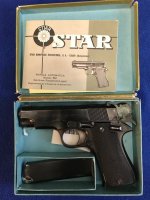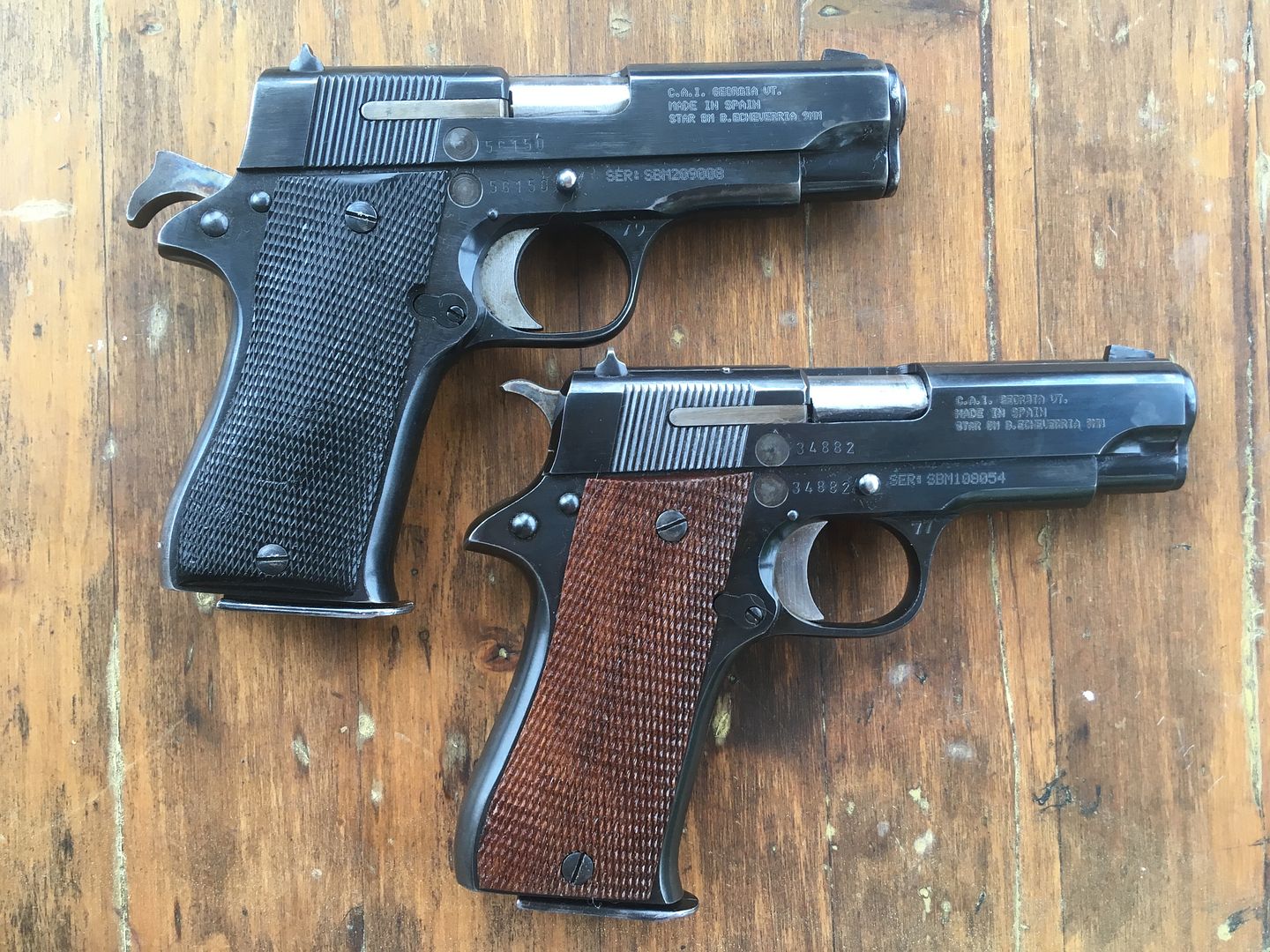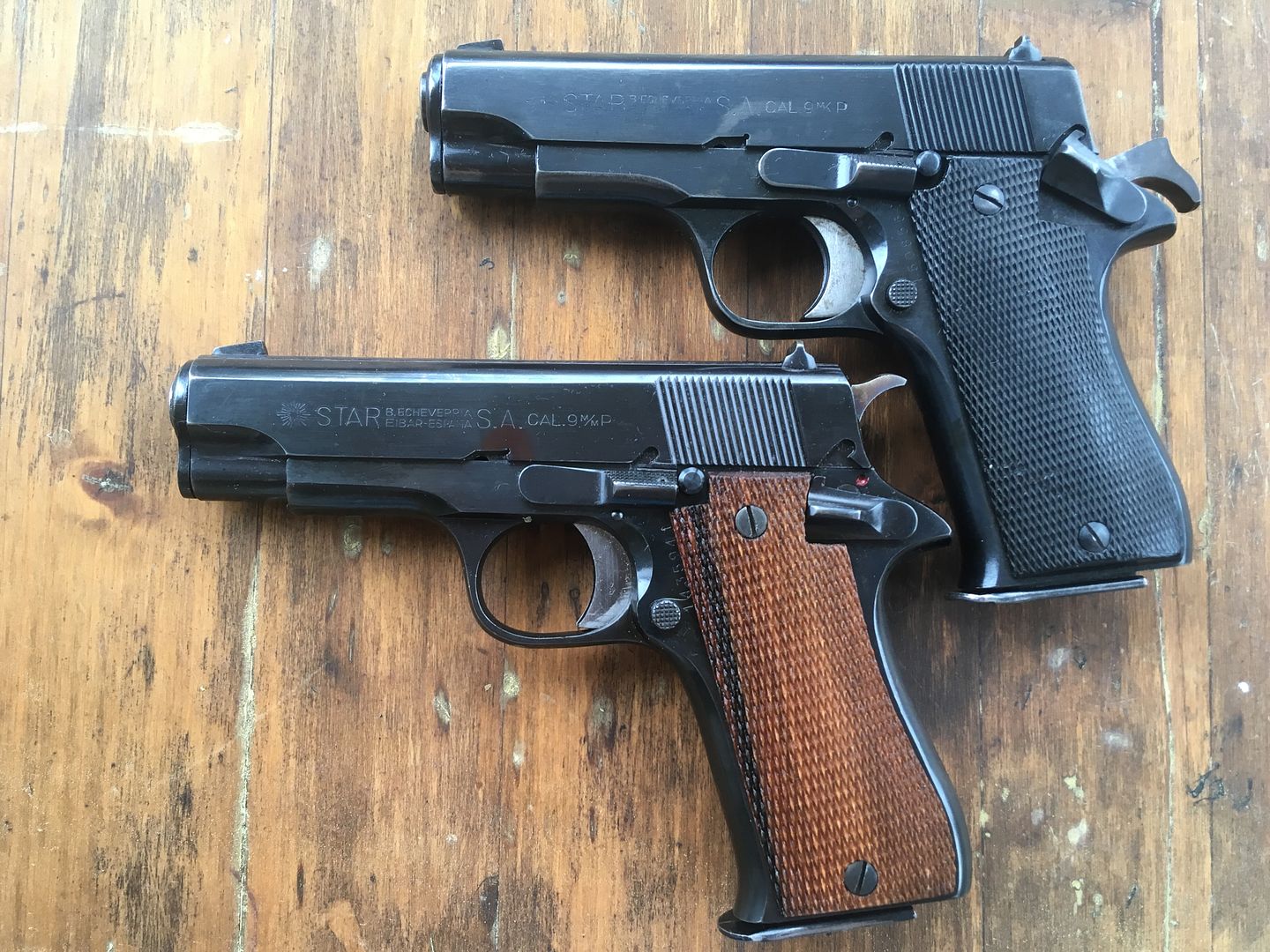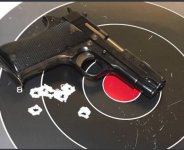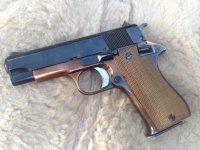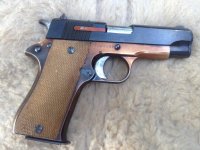I picked this up at a local gun shop a couple weeks ago for $249. It has some honest holster wear but doesn't appear to have been fired much. The bore is in perfect condition and the locking lugs and recesses show no indications of rounding or wear. The pistol was nicely polished and the blued finish still wasn't bad for it's age. The color case hardened hammer and extractor appealed to my S&W revolver tastes.
Historically speaking, I found that a total of 217,682 Star BM pistols were made between 1972 and 1992. BM serial numbers ranged from 1,226,501 to somewhere around 1,942,445. The pistols were made without mechanical variation throughout that period, but there may be a lot of different cosmetic variations depending on agency issue and commercial sales.
In general, earlier pieces were more highly polished and later ones were more of a matte finish. After serial number 1,560,901 in 1981, all BM pistols were fitted with a ramped and serrated front sight. At approximately this same serial number a few other shortcuts were used to expedite production – a shorter rollmark/slide legend, coarser polish limited to side of the slide and frame, and all the small parts were given a bead blast matte finish. The slide cocking serrations are also reduced in number on these later pistols.
The pistol has a total of three serial numbers on it. The original seven serial number on the left side of the frame in 1,500,000 rang between the trigger and the grip panel. There is a second five digit number on the right side of the frame and slide, which I suspect was a property number for a military or police agency, and it appears a crest of some sort has been milled off in front of the number. There is third number farther forward on the right side of the frame put there by CAI after "SER:" Apparently because they could not decide which number was the serial number, they figured a third number and the "SER:" prefix would clarify the situation. Idiots. I don't have a high opinion of CAI. I'll buy their imports, but I won't touch anything they've built from a parts kit on a US receiver.
There's also a "79" on the right side of the trigger guard, which I suspect was used to indicate the year it was made or acquired, as that is consistent with the date of manufacture based on the (original) serial number.
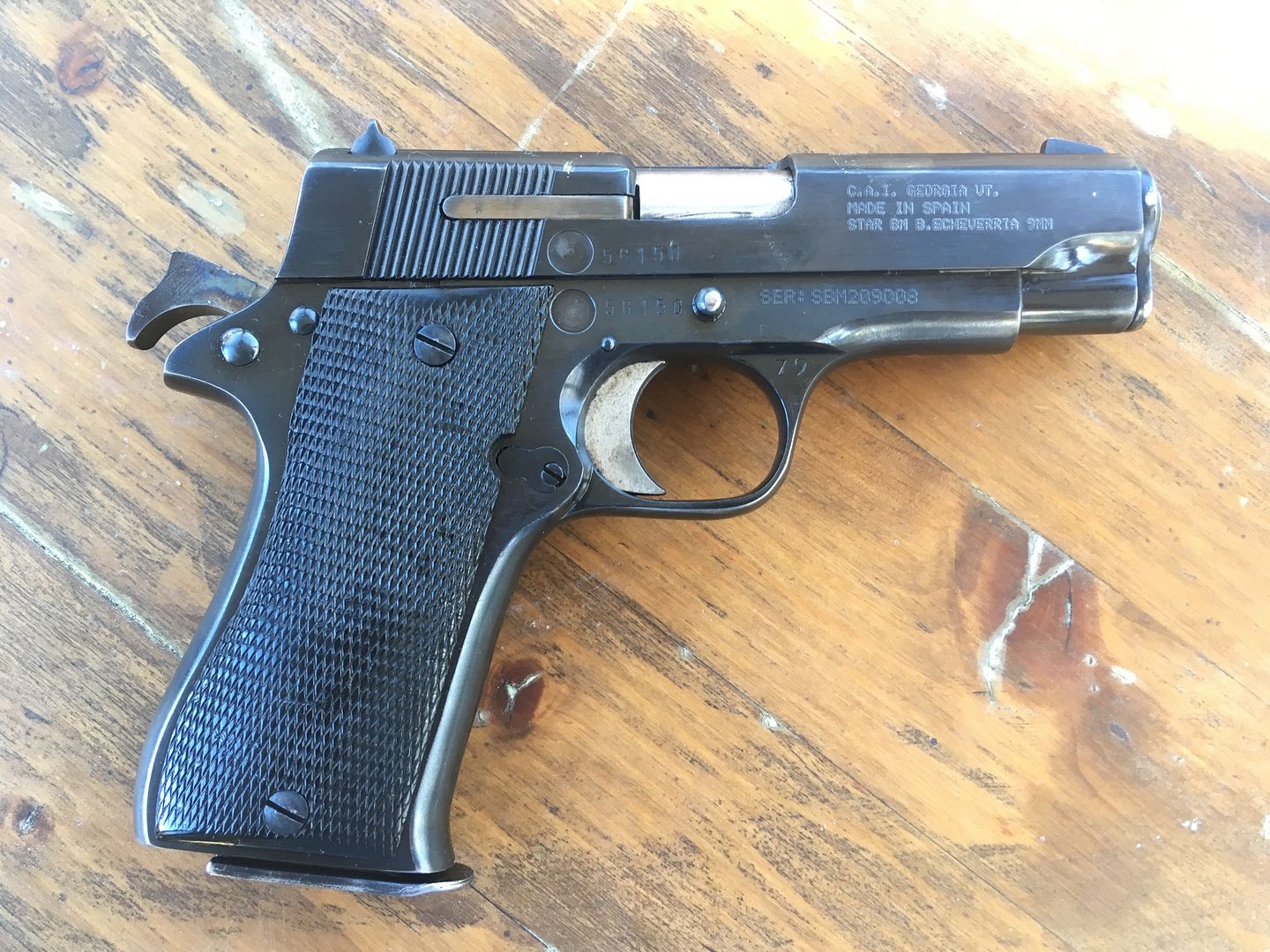
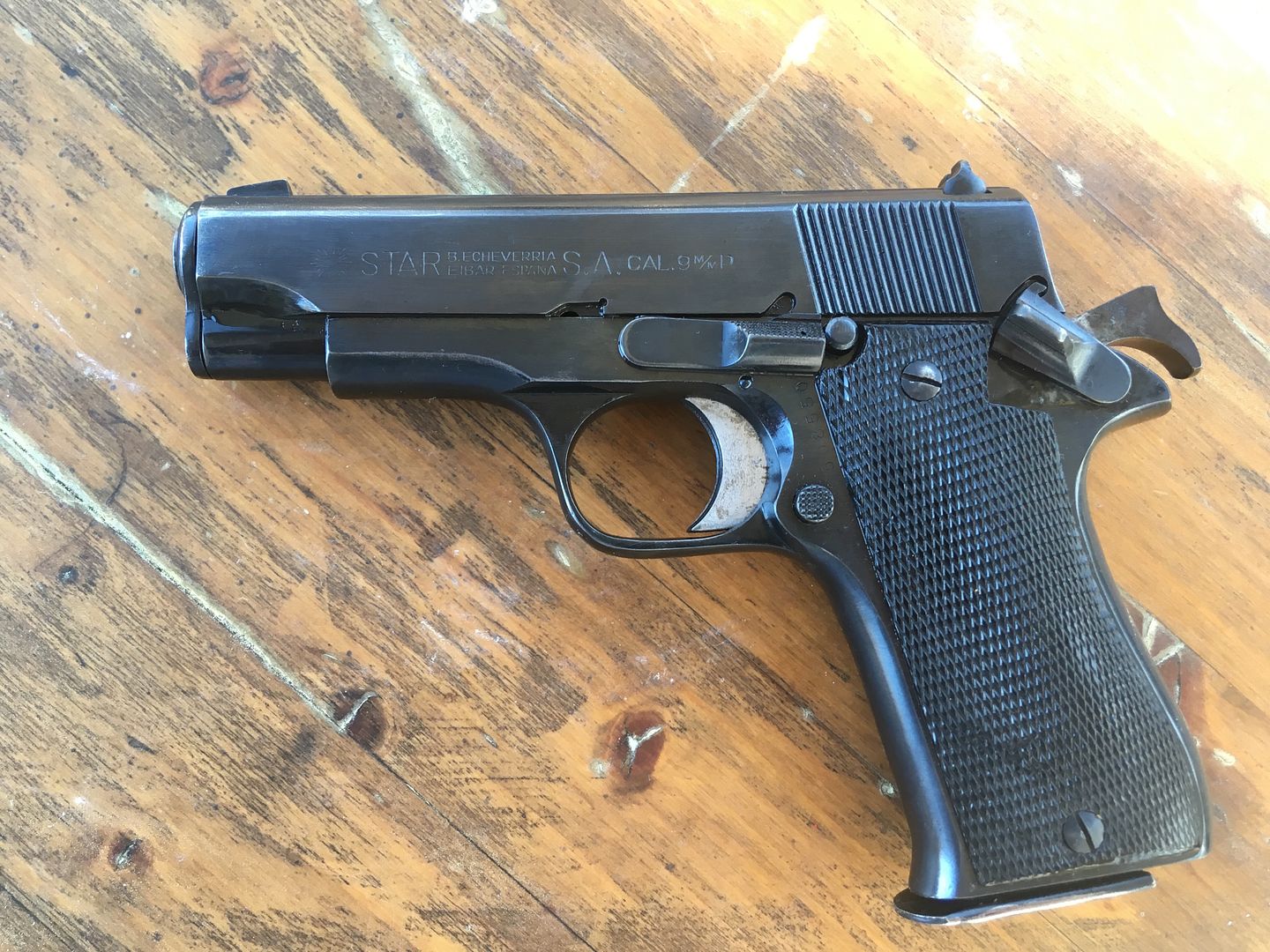
I took it out and put 50 rounds of Hornady 124 gr XTPs through it and noted an average velocity of 1,098 fps from the 3.77" barrel. I put another 50 rounds through it with a 124 gr plated round nose and 124 gr truncate cone cast hand loads. All of them shot quite well.
Functioning was almost perfect with one of the cast hand loads suffering a stove pipe ejection. I noted however that the ejection pattern was a bit too vertical and noted the recoil spring felt weaker than it should, which is one of the potential causes of stove pipes in a 1911 style pistol.
I ordered a new recoil spring from Wolffe and when it arrived, I noted it was in fact much longer and stiffer than the original. I suspect the spring it came with had been in it since it was made in 1979 and had taken a set after being in compression for nearly 40 years.
The recoil spring assembly is interesting. The front section rests in the barrel bushing and keeps it in position, while the rear section has a 1911 like base that rests on the barrel in front of the pivot pin. But it's also a captive design with the full length guide rod screwing into the base. The spring can thus be easily replaced by unscrewing the guide rod from the base while you keep the spring compressed.
The Star BM uses a barrel link like a 1911, but field stripping is a mix of 1911 and Hi Power. The slide locks back like as on an early Hi Power and the slide release lever comes out at that locked back position, unlike the 1911. However the barrel comes out through the front once the barrel bushing is removed.
I also ordered 2 surplus magazines for it for $24 each listed in very good condition. They arrived in what I'd call closer to excellent condition. Interestingly the magazine followers were flatter on these than the one in my pistol and I'm not sure when Star changed the design. Both worked equally well with all the point types I tried in the pistol.
With the new spring installed, and with three magazines in hand, I took it back to the range and put another 50 rounds of 124 gr XTPs through it as well as another 100 rounds of 124 gr plated round nose hand loads and 50 more of the 124 gr truncate cone cast hand loads. This time, functioning was letter perfect with all three loads.
I tried another slightly lower 1,000 fps 124 grain cast load and finally had it fail to lock open on the last round a couple times, which was nice since it indicates it is probably properly spring for the heavier 1,100 fps loads.
Accuracy wise it was shooting 8 and 9 shot groups that averaged 1 1/4" with the XTPs and 1 1/2" with the plated and cast loads. Now, to be fair to the pistol these are groups shot two hand, standing and it would no doubt do better off a rest - but I don't know anyone who ever shoots a semi-auto pistol that way.
This works out to about 3" at 25 yards with the XTPs and about 3 3/4" with the plated and cast loads at 25 yards. It probably isn't going to win any bullseye matched, but that's more than acceptable combat accuracy and on par with the service grade 1911s and Hi Powers I have owned over the years. The frame to slide fit is fine and I suspect if someone made a snugger match grade barrel bushing for it, it would shoot tighter groups.

The pistol is all steel and weighs 38.25 oz fully loaded (8+1), so it's not a lightweight to carry but that weight makes it very comfortable and controllable to shoot.
The trigger on it feels very good. Unlike a 1911, it pivots from the top, but after some slight initial take up the pull is very short, very crisp and breaks at 6 pounds with no creep. I tested it several times as it doesn't feel that heavy and you'd swear the scale was wrong. The trigger has a very short 1911 like resent and it is capable of producing excellent double taps and controlled pairs. It's a fun pistol to shoot.
There is no grip safety on the pistol despite the 1911 lines, but the manual safety is very positive, and doesn't just block the sear, but also lifts the hammer off the sear. I'd have no qualms carrying it in Condition 1, given that the manual safety is much more positive than the average Browning Hi Power.
The sights on the pistol are typical mid 1970s semi auto pistol sights - large enough to be easy to acquire and use for combat type shooting, but not quite as large as current practice today. They are comparable to what you'd find on a 1911 or Browning Hi Power from the same era.
The target above was shot using a 6 o'clock hold, and consequently it is shooting 2" high at 10 yards, and 5" high at 25 yards. At 50 yards it is 8" high.
I crunched the numbers and with the 124 gr XTP at 1,100 fps, it would be a maximum of 10" high at 80 yards before coming back down to 9" at 100 yards and finally zeroing at 150 yards. The good news here is that you don't have to worry about covering the target with the front blade, and at practical self defense ranges it won't matter. In fact, if you hold center of mass on a torso sized target, hitting 2"-5" higher is better anyway.
There have been some reports of cracked slides in the corner of the slide stop cut. The three I have seen personally all had a hole drilled here to provide a radius to prevent a crack from forming. With that preventative measure, I think it's a non issue.
There are some things I don't like about it however. The grip is very familiar to anyone with 1911 experience, but at the same time feels different as the front and back straps are slightly rounder, with almost no flat between the curve and the start of the grip panel. As a result, the pistol doesn't index in the hand quite as well as a 1911. The factory grips are checkered plastic, and I get the impression they were comparatively smooth when new. Mine are even smoother due to carry wear, which aggravates the indexing issue. I've ordered a set of fully checkered walnut grips for it, which should help alleviate the problem.
On the plus side the rounded grip and in particular the rounded heel on the butt make if much more comfortable to carry IWB than a 1911. Kimber charges big bucks for a rounded butt on their 1911 that is standard on the Star BM.
----
The bottom line is that it is a well made, very reliable and acceptably accurate pistol that is very enjoyable to shoot. It's also well suited to being safely carried with none of the oddities you find on some other low cost surplus pistols. And it's chambered in 9mm Para.
That is saying a lot for a $250 pistol.
Historically speaking, I found that a total of 217,682 Star BM pistols were made between 1972 and 1992. BM serial numbers ranged from 1,226,501 to somewhere around 1,942,445. The pistols were made without mechanical variation throughout that period, but there may be a lot of different cosmetic variations depending on agency issue and commercial sales.
In general, earlier pieces were more highly polished and later ones were more of a matte finish. After serial number 1,560,901 in 1981, all BM pistols were fitted with a ramped and serrated front sight. At approximately this same serial number a few other shortcuts were used to expedite production – a shorter rollmark/slide legend, coarser polish limited to side of the slide and frame, and all the small parts were given a bead blast matte finish. The slide cocking serrations are also reduced in number on these later pistols.
The pistol has a total of three serial numbers on it. The original seven serial number on the left side of the frame in 1,500,000 rang between the trigger and the grip panel. There is a second five digit number on the right side of the frame and slide, which I suspect was a property number for a military or police agency, and it appears a crest of some sort has been milled off in front of the number. There is third number farther forward on the right side of the frame put there by CAI after "SER:" Apparently because they could not decide which number was the serial number, they figured a third number and the "SER:" prefix would clarify the situation. Idiots. I don't have a high opinion of CAI. I'll buy their imports, but I won't touch anything they've built from a parts kit on a US receiver.
There's also a "79" on the right side of the trigger guard, which I suspect was used to indicate the year it was made or acquired, as that is consistent with the date of manufacture based on the (original) serial number.


I took it out and put 50 rounds of Hornady 124 gr XTPs through it and noted an average velocity of 1,098 fps from the 3.77" barrel. I put another 50 rounds through it with a 124 gr plated round nose and 124 gr truncate cone cast hand loads. All of them shot quite well.
Functioning was almost perfect with one of the cast hand loads suffering a stove pipe ejection. I noted however that the ejection pattern was a bit too vertical and noted the recoil spring felt weaker than it should, which is one of the potential causes of stove pipes in a 1911 style pistol.
I ordered a new recoil spring from Wolffe and when it arrived, I noted it was in fact much longer and stiffer than the original. I suspect the spring it came with had been in it since it was made in 1979 and had taken a set after being in compression for nearly 40 years.
The recoil spring assembly is interesting. The front section rests in the barrel bushing and keeps it in position, while the rear section has a 1911 like base that rests on the barrel in front of the pivot pin. But it's also a captive design with the full length guide rod screwing into the base. The spring can thus be easily replaced by unscrewing the guide rod from the base while you keep the spring compressed.
The Star BM uses a barrel link like a 1911, but field stripping is a mix of 1911 and Hi Power. The slide locks back like as on an early Hi Power and the slide release lever comes out at that locked back position, unlike the 1911. However the barrel comes out through the front once the barrel bushing is removed.
I also ordered 2 surplus magazines for it for $24 each listed in very good condition. They arrived in what I'd call closer to excellent condition. Interestingly the magazine followers were flatter on these than the one in my pistol and I'm not sure when Star changed the design. Both worked equally well with all the point types I tried in the pistol.
With the new spring installed, and with three magazines in hand, I took it back to the range and put another 50 rounds of 124 gr XTPs through it as well as another 100 rounds of 124 gr plated round nose hand loads and 50 more of the 124 gr truncate cone cast hand loads. This time, functioning was letter perfect with all three loads.
I tried another slightly lower 1,000 fps 124 grain cast load and finally had it fail to lock open on the last round a couple times, which was nice since it indicates it is probably properly spring for the heavier 1,100 fps loads.
Accuracy wise it was shooting 8 and 9 shot groups that averaged 1 1/4" with the XTPs and 1 1/2" with the plated and cast loads. Now, to be fair to the pistol these are groups shot two hand, standing and it would no doubt do better off a rest - but I don't know anyone who ever shoots a semi-auto pistol that way.
This works out to about 3" at 25 yards with the XTPs and about 3 3/4" with the plated and cast loads at 25 yards. It probably isn't going to win any bullseye matched, but that's more than acceptable combat accuracy and on par with the service grade 1911s and Hi Powers I have owned over the years. The frame to slide fit is fine and I suspect if someone made a snugger match grade barrel bushing for it, it would shoot tighter groups.

The pistol is all steel and weighs 38.25 oz fully loaded (8+1), so it's not a lightweight to carry but that weight makes it very comfortable and controllable to shoot.
The trigger on it feels very good. Unlike a 1911, it pivots from the top, but after some slight initial take up the pull is very short, very crisp and breaks at 6 pounds with no creep. I tested it several times as it doesn't feel that heavy and you'd swear the scale was wrong. The trigger has a very short 1911 like resent and it is capable of producing excellent double taps and controlled pairs. It's a fun pistol to shoot.
There is no grip safety on the pistol despite the 1911 lines, but the manual safety is very positive, and doesn't just block the sear, but also lifts the hammer off the sear. I'd have no qualms carrying it in Condition 1, given that the manual safety is much more positive than the average Browning Hi Power.
The sights on the pistol are typical mid 1970s semi auto pistol sights - large enough to be easy to acquire and use for combat type shooting, but not quite as large as current practice today. They are comparable to what you'd find on a 1911 or Browning Hi Power from the same era.
The target above was shot using a 6 o'clock hold, and consequently it is shooting 2" high at 10 yards, and 5" high at 25 yards. At 50 yards it is 8" high.
I crunched the numbers and with the 124 gr XTP at 1,100 fps, it would be a maximum of 10" high at 80 yards before coming back down to 9" at 100 yards and finally zeroing at 150 yards. The good news here is that you don't have to worry about covering the target with the front blade, and at practical self defense ranges it won't matter. In fact, if you hold center of mass on a torso sized target, hitting 2"-5" higher is better anyway.
There have been some reports of cracked slides in the corner of the slide stop cut. The three I have seen personally all had a hole drilled here to provide a radius to prevent a crack from forming. With that preventative measure, I think it's a non issue.
There are some things I don't like about it however. The grip is very familiar to anyone with 1911 experience, but at the same time feels different as the front and back straps are slightly rounder, with almost no flat between the curve and the start of the grip panel. As a result, the pistol doesn't index in the hand quite as well as a 1911. The factory grips are checkered plastic, and I get the impression they were comparatively smooth when new. Mine are even smoother due to carry wear, which aggravates the indexing issue. I've ordered a set of fully checkered walnut grips for it, which should help alleviate the problem.
On the plus side the rounded grip and in particular the rounded heel on the butt make if much more comfortable to carry IWB than a 1911. Kimber charges big bucks for a rounded butt on their 1911 that is standard on the Star BM.
----
The bottom line is that it is a well made, very reliable and acceptably accurate pistol that is very enjoyable to shoot. It's also well suited to being safely carried with none of the oddities you find on some other low cost surplus pistols. And it's chambered in 9mm Para.
That is saying a lot for a $250 pistol.
Last edited:

